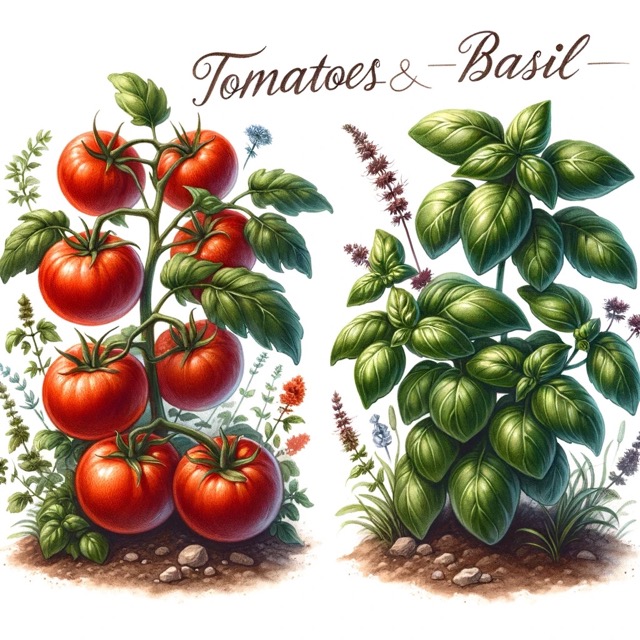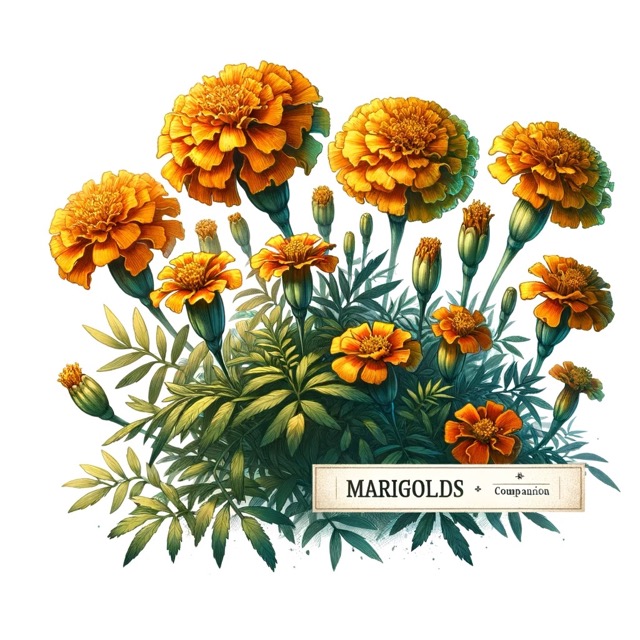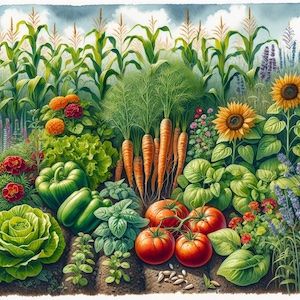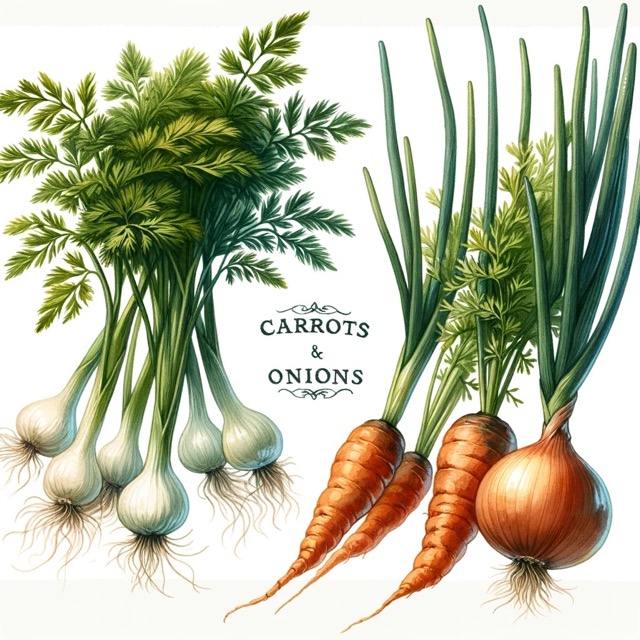What is companion planting in the garden?
Using a garden planting strategy to help grow, protect and maintain your plants
Introduction
Gardening, a timeless activity, offers endless opportunities for learning and experimentation. One of the most fascinating aspects of gardening is “Companion Planting,” a practice that can significantly enhance the health and yield of your plants. This guide delves into the heart of companion planting, exploring its definition, biological mechanisms, and practical applications for both vegetables and flowers.
What is Companion Planting?
Companion planting is an agricultural practice that involves growing different plants in proximity for mutual benefit. This method has been recognized and used for centuries by various cultures around the world. It relies on the natural relationships between plants to create a healthier, more productive garden or farm. Here’s what companion planting provides
- Pest Prevention – Certain plants can deter specific pests naturally. For example,
- Marigolds release a substance from their roots that repels nematodes.
- Garlic and onions can deter rabbits and deer with their strong scent.
- Herbs like mint and basil can help keep away various insects.
- Natural Shade – Larger plants can provide shade for smaller, more shade-tolerant plants. This natural shading can protect delicate leaves from the harsh sun, reduce water evaporation, and cool the soil, creating a microclimate that benefits certain plants.
- Improved Nutrient Utilization – Some plants, like beans and other legumes, fix nitrogen in the soil, which benefits neighboring plants that require more nitrogen to grow.
- Spatial Interactions – Companion planting maximizes space usage by combining plants with different growth habits or rates, like tall sunflowers with low-growing strawberries.
- Attract Beneficial Insects – Flowering companions can attract pollinators necessary for fruit and vegetable plants to produce crops. They can also attract beneficial insects that prey on pest species.
- Soil Health – Deep-rooted plants can help to break up the soil, which can aid in the growth of plants with shallower roots. Additionally, some plants can help to suppress weeds, thus maintaining soil integrity.
- Plant Support – Tall, sturdy plants can serve as natural trellises for climbing plants like peas and beans.
- Disease Suppression – The diversity of plants in companion planting can help prevent the spread of plant diseases that might otherwise wipe out a monoculture.
- Increased Biodiversity – Companion planting encourages a diverse ecosystem which can lead to healthier soil and plants, and can also support a wider range of wildlife.
In essence, companion planting is a holistic approach to gardening and farming that considers the complex interplay between different plant species and leverages these relationships to create a more dynamic and resilient growing environment.
Historical Background
Rooted in ancient agriculture, companion planting has been practiced worldwide for centuries. Indigenous peoples have long understood its benefits:
- The Native Americans used the “Three Sisters” method (corn, beans, and squash), where each plant supports the others.
- In Asia, particularly in China and Japan, farmers practiced intercropping with rice and fish, creating a balanced ecosystem.
- Ancient Egyptians planted wheat and barley together, which improved soil fertility and yields.
These historical practices laid the foundation for modern companion planting principles.
The Biology of How It Works
Companion planting works through several biological mechanisms:
- Nutrient Sharing – Different plants require varying nutrients from the soil. When compatible plants are grown together, they can optimize the use of soil nutrients.
- Pest Control – Certain plants can repel pests naturally, protecting neighboring plants. For example, marigolds emit a substance that deters nematodes and other pests.
- Pollination Support – Planting flowering companions can attract pollinators, which is beneficial for fruit and vegetable plants needing pollination.
- Physical Support – Tall plants can provide shade or support for smaller plants. For instance, corn stalks can serve as natural trellises for climbing beans.
- Allelopathy – Some plants release chemicals that can inhibit or promote the growth of other plants. This phenomenon is known as allelopathy.
Vegetable Common Companions
In vegetable gardens, companion planting can boost yields and reduce pest issues:

- Tomatoes – Basil enhances flavor and repels flies and mosquitoes. Marigolds deter nematodes.
- Carrots – Planting carrots with onions can help repel carrot flies.
- Lettuce – Growing lettuce under taller plants like tomatoes or beans provides necessary shade.
- Peppers – Companion plants for peppers include onions, spinach, and tomatoes.
- Beans – Corn and beans work well together, as beans fix nitrogen in the soil which benefits corn.
Flower Common Companions
Flowers not only add beauty to the garden but also support companion planting:
- Marigolds – Great companions for many vegetables, repelling pests and attracting beneficial insects.
- Nasturtiums – Ideal for planting near squash and cucumbers to repel pests.
- Sunflowers – Attract pollinators and can provide shade or support for smaller plants.
- Lavender – Known for its aroma, repels deer and rabbits, and attracts pollinators.

Additional Companion Planting Tips
- Herbs – Many herbs like rosemary, thyme, and mint are excellent companions due to their strong scents that deter pests.
- Avoiding Bad Combinations – Just as some plants benefit each other, others can be detrimental. For example, garlic and onions can inhibit the growth of beans and peas.
- Crop Rotation – Rotating crops in subsequent years can prevent soil depletion and pest buildup.
- Soil Health – Maintaining healthy soil is crucial for successful companion planting. Regular composting and mulching can significantly improve soil quality.
Full Companion Planting Chart
Below is a plant companion chart of the most common pairings/companions for a healthy garden.
| Plant | Companions |
|---|---|
| Asparagus | Tomatoes, Parsley, Basil |
| Beans | Corn, Squash, Marigolds |
| Beets | Onions, Cabbage, Marigolds |
| Broccoli | Celery, Chamomile, Rosemary |
| Corn | Beans, Squash, Peas |
| Cucumber | Beans, Celery, Dill |
| Garlic | Beets, Kale, Potatoes |
| Kale | Beets, Celery, Cucumber |
| Lettuce | Carrots, Radish, Strawberries |
| Okra | Peppers, Melons, Cucumbers |
| Onions | Beets, Carrots, Lettuce |
| Peas | Carrots, Cucumbers, Corn |
| Peppers | Basil, Onions, Spinach |
| Potatoes | Corn, Cabbage, Marigolds |
| Roses | Garlic, Onions, Marigolds |
| Squash | Beans, Corn, Nasturtiums |
| Strawberries | Spinach, Lettuce, Borage |
| Tomatoes | Basil, Marigolds, Asparagus |
This table can serve as a reference for planning your garden and implementing companion planting strategies.
The Anti-Companion Chart
As in life, there are things you should do, and things you should not do. Here is the “anti-companion” plating list for your garden, or pairings you should avoid.
| Vegetable 1 | Vegetable 2 | Reason for Incompatibility | Additional Considerations |
|---|---|---|---|
| Tomatoes | Potatoes | Increased risk of blight and other diseases | |
| Beans | Onions | Onions can inhibit the growth of beans | |
| Carrots | Parsnips | Attract similar pests, increasing infestation risk | |
| Cucumbers | Aromatic herbs | Some herbs can inhibit growth, others are beneficial | Dill and borage are exceptions, attracting helpful insects |
| Broccoli | Strawberries | Broccoli can hinder strawberry growth | |
| Peas | Garlic | Garlic can inhibit the growth of peas | Similar to onions, the effect is somewhat debatable |
| Cabbage | Cauliflower | Compete for the same nutrients, attract same pests | |
| Asparagus | Garlic | Garlic can stunt asparagus growth | |
| Lettuce | Celery | Different water needs | Celery requires more water than lettuce |
| Spinach | Potatoes | Potatoes might inhibit spinach growth | The evidence is mixed |
| Radishes | Hyssop | Potential growth stunt, but limited information | |
| Beets | Pole Beans | Pole beans can inhibit beet growth | |
| Zucchini | Pumpkins | Risk of cross-pollination affecting seed quality | Not an issue unless saving seeds |
| Onions | Peas | Onions may inhibit pea growth | The allelopathic effect is debatable |
| Corn | Tomatoes | Potential for increased pest environment | Not specific pest attraction, but general risk increase |
Conclusion
Companion planting is a sustainable and efficient way to enhance your garden’s productivity and health. By understanding the relationships between different plants and utilizing their natural synergies, gardeners can create thriving, diverse, and ecologically sound gardens. Whether you’re a seasoned gardener or a beginner, incorporating companion planting into your garden strategy can yield fruitful and rewarding results. By embracing these practices, you not only grow plants; you cultivate harmony and balance in your garden ecosystem. Companion planting is indeed a testament to the interconnectedness of nature and the wisdom embedded within it. Happy gardening! If you have other questions, you can read our companion planting guide.
Companion Planting FAQ
- Q: What is companion planting?
- A: Companion planting is the practice of growing different plants together to enhance growth, deter pests, attract beneficial insects, and improve overall garden health. It leverages the natural relationships between plants to create a balanced and thriving garden ecosystem.
- Q: How does companion planting benefit flowers?
- A: Companion planting benefits flowers by:
- Repelling pests: Certain plants produce natural chemicals that deter insects and other pests.
- Attracting beneficial insects: Some plants attract pollinators like bees and butterflies, as well as predatory insects that control harmful pests.
- Enhancing growth: Plants can complement each other by improving soil conditions, providing shade or support, and reducing competition for nutrients.
- Improving soil health: Some plants, such as legumes, fix nitrogen in the soil, enriching it for their companions.
- A: Companion planting benefits flowers by:
- Q: What are some common companion plants for flowers?
- A: Here are some popular companion plant pairings:
- Marigold and Roses: Marigolds repel nematodes and aphids, benefiting rose health.
- Nasturtium and Petunia: Both deter aphids and attract pollinators.
- Lavender and Echinacea: Lavender repels moths and attracts pollinators, while Echinacea improves biodiversity.
- Sunflower and Zinnia: Sunflowers provide support and attract pollinators, complementing Zinnia’s vibrant display.
- Calendula and Cosmos: Calendula repels pests and attracts pollinators, while Cosmos enhances the garden’s beauty.
- A: Here are some popular companion plant pairings:
- Q: How do I plan a companion planting flower garden?
- A: To plan a companion planting flower garden:
- Identify your goals: Determine if you want to repel specific pests, attract pollinators, improve soil health, or enhance growth.
- Choose compatible flowers: Select flowers that benefit each other based on your goals.
- Consider garden layout: Plan your garden layout to ensure plants with similar water, light, and soil requirements are grouped together.
- Rotate crops: Rotate plants each season to prevent soil depletion and reduce the risk of disease.
- A: To plan a companion planting flower garden:
- Q: Can companion planting be used in containers or small spaces?
- A: Yes, companion planting can be effectively used in containers, raised beds, and small garden spaces. The principles remain the same: choose compatible plants that benefit each other and arrange them to maximize their positive interactions. Companion planting in containers can also help manage pests and attract beneficial insects to smaller areas.
- Q: Are there any plants that should not be planted together?
- A: Yes, some plants do not grow well together and can hinder each other’s growth. For example:
- Fennel and most flowers: Fennel can inhibit the growth of nearby plants.
- Onions and certain flowers: Onions may not pair well with flowers like gladiolus, as they can stunt growth. It’s important to research specific plant pairings to avoid negative interactions.
- A: Yes, some plants do not grow well together and can hinder each other’s growth. For example:
- Q: How can I attract beneficial insects with companion planting?
- A: To attract beneficial insects:
- Plant flowers with high nectar content: Flowers like marigolds, cosmos, and lavender attract bees, butterflies, and predatory insects.
- Include a variety of plants: A diverse garden with different flower shapes, colors, and blooming times will attract a wider range of beneficial insects.
- Provide habitats: Create insect-friendly environments with features like water sources, shelter, and undisturbed areas for nesting.
- A: To attract beneficial insects:
- Q: How does companion planting impact soil health?
- A: Companion planting can improve soil health by:
- Fixing nitrogen: Plants like legumes enrich the soil with nitrogen, benefiting surrounding plants.
- Preventing soil erosion: Ground cover plants like sweet alyssum protect soil from erosion and retain moisture.
- Enhancing microbial activity: Diverse plantings support a variety of soil microorganisms, promoting healthy soil structure and nutrient cycling.
- A: Companion planting can improve soil health by:
Recent Posts

The Ultimate Guide to Philodendron Birkin – Care, Tips, and Benefits

Watering Plants – Indoor Edition

The Advantages of Built-Up Garden Beds: A Gardener’s Best Friend

The Secret Weapon for Lush Blooms: How to Create the Perfect Fertilizer Schedule

Create a Stunning Cottage Garden with These Easy-to-Grow Flowers












You must be logged in to post a comment.